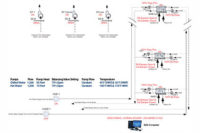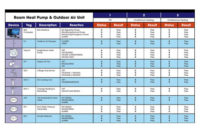Retro-Commissioning Application
Last month, we discussed how to identify energy retrocommissioning opportunities and who makes up the energy retrocommissioning team which will include the school’s energy conservation committee, facility manager, ATC operator, commissioning engineer, testing, adjusting, and balancing (TAB) engineer, and if possibly a LEED® Accredited Professional. We discussed three prerequisites to pursuing energy retrocommissioning opportunities which are:
• Collect the utility bills and convert the energy used into Btuh/sq ft/yr.
•
Based on the results, if it makes good business sense to proceed further with a potential energy retrocommissioning opportunity.
•
Equally important is the documenting of the basis of design (BofD) for the original HVAC design and the future HVAC design (once the energy retrocommissioning solution plan is mutually agreed upon.
Energy retrocommissioning is a quality control (QC) initiative and follows the same steps as industry’s QC procedures (e.g., www.cqm.org/) beginning with data collection phase. This month, we continue to collect data and analyze the data so that we clearly understand the existing HVAC operating conditions and operational issues and begin to identify potential enhancements to this HVAC system. For some, there is the tendency to jump to the solution based on their experience, but no matter how experienced an energy auditor is (or thinks she is), it is imperative to follow the QC process of data collection, data analysis, solution planning, solution implementation, and monitor-measure-benchmark the results.
A significant “next step” in the energy retrocommissioning data collection phase is to have a TAB firm complete an existing system condition assessment. This is a data collection method that many energy auditors will overlook for a variety of reasons beginning with a lack of appreciation for the value of air and water balancing.
To proceed with this step you should procure a TAB professional, have her create a TAB system flow diagram that documents original design conditions, and then go out and record actual conditions. Before the TAB engineer can complete the flow diagram, she must also review the original BofD and the proposed BofD to help understand how the system is to work. It is important to note the commissioning engineer can complete the existing condition ATC/FPT pass-fail documentation (see last month’s B2B for example) at the same time the TAB engineer is completing the design-to-actual documentation.
The TAB engineer should review record drawings, existing equipment shop drawings, and if necessary, make a “best guess” as to the original design calculations (e.g., pressure drop across the strainer) based on her experience with water system pressure drops. This information is inputted in the TAB system flow diagram TAB-3 software to document the estimated “design” pressure drop readings.
Next, the TAB engineer completes the water system readings, documenting the actual flow, pressure drop, and velocity within the software program. Now the auditors have design-to-actual data to analyze. All deficiencies should be added to the commissioning engineer’s corrective action log.
This month’s test requires readers to select the correct answers in each of the remarks column next to each water pressure drop reading. Refer to the B2B page two TAB system flow diagram and note design-to-actual findings. The answers can be found at www.esmagazine.com.
After documenting the current operating conditions via the ATC/FPT and TAB processes, the energy retrocommissioning team should have sufficient information to begin to shape an energy retrocommissioning solution(s). At this point in time, the energy retrocommissioning team will meet and, using the data collected, will complete the data analysis phase. It is also important to note that feedback from interviewing school occupants is an essential part of the data collection process, too. Based on this analysis, one or more solutions will begin to take shape and form the solution planning phase recommendations, along with potential energy retrofit opportunities that will have an ROI.
When coordinating the ATC/FPT-TAB initiative, the auditors should use an equipment assessment checklist to complete a static condition assessment of the equipment/system and to also identify energy retrocommissioning opportunities. See “The Facility Files” column for a sample equipment assessment checklist for a unit ventilator. Any deficiencies identified via the checklist need to be added to the corrective action log. It is important to note that auditors should not assume there were no installation problems that were never identified prior to the building owner accepting the HVAC systems for this school building (e.g., systems were never commissioned). These deficiencies may be an integral part of the energy retrocommissioning issues and concerns and may have compromise system performance and energy wasted in the past.
With data analysis phase and solution planning phase completed, the energy retrocommissioning team can reformat the corrective action log into a “matrix of opportunity” or energy conservation measure (ecm) report for presentation to those funding the energy retrocommissioning project. This will lead to the solution implementation phase. An example of ROI parameters established for this B2B series are the following:
ECM Implementation Levels
Level 1 = Quick-fix ROI
Level 2 = 1- to 2-yr ROI
Level 3 = 2+ to 4-yr ROI
Level 4 = 4+ to 6-yr ROI
Of the four levels of energy retrocommissioning solutions, the quick-fix solutions are usually action items that can be done by simply changing a setpoint, issuing a maintenance workorder request, or some other corrective measure that the in-house staff can do without obtaining additional operating budget funds.
Frequently Level 2 energy retrocommissioning solutions can also be completed relatively quickly and without pursuing additional funding but more often these ECM’s will require some solution planning and implementation. Most likely Level 2+ year ROI will require funding and this means competing for the financing along with other operating groups looking for funding. With energy retrocommissioning, you may find that the local utility company will be very interested in contributing to your energy initiative which can reduce your estimated ROI by 50% or more when outside funding/contributions are available.
Based on the data analysis and the solution planning, which should include financial planning of the energy retrocommissioning initiatives, an authorization to proceed will allow you to move forward with the solution implementation phase.







